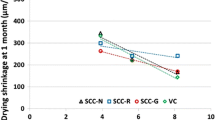Abstract
Shrinkage in hydraulic materials is a complex time-dependent process. For standard concretes, one of the most considerable parts of shrinkage is drying shrinkage. In fact, to predict deformations of concrete due to shrinkage, various predictive models have been developed; most of them use many numbers of factors that can affect shrinkage such as concrete strength, concrete age of loading, curing conditions type, ambient conditions, type of cement and aggregates, water to cement ratio, concrete mix, member shape and size, loading duration and type. Such a number of parameters increases the complexity of using these models and leads to some prediction imperfections; thence a new simplified model is needed. The main target of the current paper is to formulate a novel and simplified model with a minimum of factors that affect drying shrinkage behavior as relative humidity and volume to surface area ratio of the concrete element (V/S). To achieve this goal, a prediction model based on probability density function and a small number of parameters that influence shrinkage, as well as relative humidity and volume to surface area ratio of the concrete element, has been developed. A huge database has been used to adjust the model's parameters using the most recent studies and research to validate the model. The comparison of the model predictions with experimental results reveals that the simplified model is well adapted to represent and describe the evolution of drying shrinkage for normal, high-performance, lightweight, and self-compaction concretes, whereas there is negligible prediction divergence as compared to other existed models.














Similar content being viewed by others
Code availability
There is no code in this study.
References
Mcdonald DB, Brooks JJ, Burg RG et al (2014) Report on factors affecting shrinkage and creep of hardened concrete reported by ACI committee 209. Am Concr Inst ACI 209(1):1–12
Al-Saleh SA (2014) Comparison of theoretical and experimental shrinkage in concrete. Constr Build Mater 72:326–332. https://doi.org/10.1016/j.conbuildmat.2014.06.050
Bal L, Buyle-Bodin F (2013) Artificial neural network for predicting drying shrinkage of concrete. Constr Build Mater 38:248–254. https://doi.org/10.1016/j.conbuildmat.2012.08.043
Bazant ZP, Murphy WP (1995) Creep and shrinkage prediction model for analysis and design of concrete structures—model B3. Mater Constr 28:357–365. https://doi.org/10.1007/bf02486204
Bažant ZP, Havlásek P, Jirásek M (2014) Microprestress-solidification theory: modeling of size effect on drying creep. Comput Model Concr Struct Proc EURO-C 2014:749–758
RILEM Technical Committee TC-242-MDC (Zdeněk PB chair) (2015) RILEM draft recommendation: TC-242-MDC multi-decade creep and shrinkage of concrete: material model and structural analysis*: Model B4 for creep, drying shrinkage and autogenous shrinkage of normal and high-strength concretes with multi-decade applicability. Mater Struct Constr 48:753–770. https://doi.org/https://doi.org/10.1617/s11527-014-0485-2
Bažant ZR, Li GH (2008) Unbiased statistical comparison of creep and shrinkage prediction models. ACI Mater J 105:610–621. https://doi.org/10.14359/20203
Bažant ZP (2001) Prediction of concrete creep and shrinkage: Past, present and future. Nucl Eng Des 203:27–38. https://doi.org/10.1016/S0029-5493(00)00299-5
Bazant ZP, Wittmann FH, Kim JK, Alou F (1987) Statistical extrapolation of shrinkage data—part I: regression. ACI Mater J 84:20–34. https://doi.org/10.14359/1947
International Federation for Structural Concrete (2012) fib Model Code 2010—Final Draft 1 and 2. fib Bull 65–66:350–374s
Muller HS, Kuttner CH, Kvitsel V (1999) Muller RFGC—creep and shrinkage models of normal and high-performance concrete—concept for a unified code-type approach. Rev française génie Civ 3:113–132
Scholz F (2002) Weibull Reliability Analysis. Boeing 5:1–76
Oger R, Saporta G (1991) Probabilites, Analyse des Donnees et Statistique. Biometrics 47:783. https://doi.org/10.2307/2532171
Concrete S (1990) Textbook on Behaviour. Des Performance Updat Knowl CEB/FIP Model Code 1
Afroughsabet V, Teng S (2020) Experiments on drying shrinkage and creep of high performance hybrid-fiber-reinforced concrete. Cem Concr Compos 106:103481. https://doi.org/10.1016/j.cemconcomp.2019.103481
Afroughsabet V, Biolzi L, Ozbakkaloglu T (2017) Influence of double hooked-end steel fibers and slag on mechanical and durability properties of high performance recycled aggregate concrete. Compos Struct 181:273–284. https://doi.org/10.1016/j.compstruct.2017.08.086
Amran YHM (2020) Influence of structural parameters on the properties of fibred-foamed concrete. Innov Infrastruct Solut 5:16. https://doi.org/10.1007/s41062-020-0262-8
Labbé S, Lopez M (2020) Towards a more accurate shrinkage modeling of lightweight and infra-lightweight concrete. Constr Build Mater 246:118369. https://doi.org/10.1016/j.conbuildmat.2020.118369
Güneyisi E, Gesolu M, Özbay E (2010) Strength and drying shrinkage properties of self-compacting concretes incorporating multi-system blended mineral admixtures. Constr Build Mater 24:1878–1887. https://doi.org/10.1016/j.conbuildmat.2010.04.015
Gupta N, Siddique R (2020) Sulfate resistance and drying shrinkage of self-compacting concrete incorporating copper slag. J Mater Civ Eng 32:04020389. https://doi.org/10.1061/(asce)mt.1943-5533.0003501
Sakata K, Shimomura T (2004) Recent progress in research on and code evaluation of concrete creep and shrinkage in Japan. J Adv Concr Technol 2:133–140. https://doi.org/10.3151/jact.2.133
Gardner NJ, Lockman MJ (2001) Design provisions for drying shrinkage and creep of normal-strength concrete. ACI Mater J 98:159–167. https://doi.org/10.14359/10199
Vinkler M, Vítek JL (2017) Drying shrinkage of concrete elements. Struct Concr 18:92–103. https://doi.org/10.1002/suco.201500208
Gaylard PC, Ballim Y, Fatti LP (2013) A model for the drying shrinkage of South African concretes. J South Afr Inst Civ Eng 55:45–59
Union E (2004) Eurocode 2: design of concrete structures—part 1–1: general rules and rules for buildings. Br Stand Inst 1:124–132
Funding
Not applicable.
Author information
Authors and Affiliations
Corresponding author
Ethics declarations
Conflict of interest
The authors declare that there is no conflict of interest in presenting this manuscript.
Availability of data and material
The data of this research is available.
Rights and permissions
About this article
Cite this article
Kebir, A., Brahma, A. Modeling the drying shrinkage of structural concretes. Innov. Infrastruct. Solut. 6, 151 (2021). https://doi.org/10.1007/s41062-021-00519-8
Received:
Accepted:
Published:
DOI: https://doi.org/10.1007/s41062-021-00519-8



